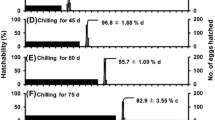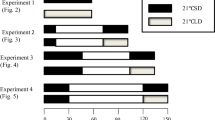Summary
Developing eggs of Metrioptera roeseli HGB. have an obligate “embryonic” diapause in stage 23 and a facultative “initial” diapause in stage 4. Initial diapause is lacking when the ovipositing females are kept at long day photoperiod (LD 16/8), but is induced at LD 14/10 and LD 8/16. When natural light conditions are given in the laboratory, the females mostly lay diapausing eggs from the end of August onwards. In eggs without initial diapause, a larger number of embryos reach a stage, in which the embryonic diapause can be broken by chilling, only at favorable temperature (4 weeks at 24°C or 8 at 18°C) and in contact with water before the first winter. Thus, some individuals of a given population of M. roeseli have an annual, others a biennial life cycle. The variability in the duration of egg development is due to a photoperiodically induced, facultative initial diapause and to a possible quiescence caused by insufficient temperature and/or moisture.
Similar content being viewed by others

References
Andrewarth HG (1952) Diapause in relation to the ecology of insects. Biol Rev 27:50–107
Brown VK (1983) Developmental strategies in British Dictyoptera: Seasonal variation. In: Brown VK, Hodek I (eds) Diapause and life cycle strategies in insects. Dr W Junk Publishers, The Hague, Boston London, pp 111–125
Browning TO (1952) The influence of temperature on the completion of diapause in the eggs of Gryllus commodus Walker. Aust J Sci Res B5:112–127
Church NS, Salt RW (1952) Some of the effects of temperature on development and diapause in eggs of Melanoplus bivittatus (Say) (Orthoptera: Acrididae). Canad J Zool 30:173–184
Dean RL, Hartley JC (1977)a Egg diapause in Ephippiger cruciger (Orthoptera: Tettigoniidae) I. The incidence, variable duration and elimination of the initial diapause. J exp Biol 66:173–183
Dean RL, Hartley JC (1977)b Egg diapause in Ephippiger cruciger (Orthoptera: Tettigoniidae) III. Abnormal development through the final egg diapause. J exp Biol 66:173–183
Deura K, Hartley JC (1982) Initial diapause and embryonic development in the speckled bush-cricket, Leptophyes punctatissima. Physiological Entomology 7:253–262
Hartley JC, Warne AC (1972) The developmental biology of the egg stage of Western European Tettigoniidae (Orthoptera). J Zool Lond 168:267–298
Hartley JC, Warne AC (1973) The distribution of Pholidoptera griseoaptera (Orthoptera: Tettigoniidae) in England and Wales related to accumulated temperatures. J Anim Ecol 42:531–537
Harz K (1957) Die Geradflügler Mitteleuropas. VEB Gustav Fischer Verlag, Jena, pp 1–494
Helfert B (1980) Die regulative Wirkung von Photoperiode und Temperatur auf den Lebenszyklus ökologisch unterschiedlicher Tettigoniiden-Arten (Orthoptera, Saltatoria) 2. Teil: Embryogenese und Dormanz der Filialgeneration. Zool Jb Syst 107:449–500
Helfert B, Sänger K (1976) Vergleichende Untersuchungen über die Temperatursummierung von Laubheuschrecken (Orthoptera: Tettigoniidae) während der Embryogenese. Zool Anz Jena 196:43–60
Ingrisch S (1978) Labor- und Freilanduntersuchungen zur Dauer der postembryonalen Entwicklung einiger mitteleuropäischer Laubheuschrecken (Orthoptera: Tettigoniidae) und ihre Beeinflussung durch Temperatur und Feuchte. Zool Anz Jena 200:309–320
Ingrisch S (1979) Untersuchungen zum Einfluß von Temperatur und Feuchtigkeit auf die Embryogenese einiger mitteleuropäischer Laubheuschrecken (Orthoptera: Tettigoniidae). Zoologische Beiträge 25:343–364
Masaki S (1972) Climatic adaption and photoperiodic response in the band-legged ground cricket. Evolution 26:587–600
Müller HJ (1966) Probleme der Insektendiapause. Zool Anz Suppl 29:192–222
Saunders DS (1982) Insect clocks 2nd ed. Pergamon Press, Oxford-New York-Toronto-Sydney-Paris-Frankfurt, pp 1–409
Tauber MJ, Tauber CA (1976) Insect seasonality: diapause maintenance, termination, and postdiapause development. Ann Rev Ent 21:81–107
Wardhaugh KG (1980) The effects of temperature and photoperiod on the induction of diapause in eggs of the Australian plague locust, Chortoicetes terminifera (Walker) (Orthoptera: Acrididae). Bull Ent Res 70:635–647
Warne AC (1972) Embryonic development and the systematics of the Tettigoniidae (Orthoptera: Saltatoria). Int J Insect Morphol & Embryol 1:1–21
Winston PW, Bates DH (1960) Saturated solutions for the control of humidity in biological research. Ecology 41:232–237
Author information
Authors and Affiliations
Rights and permissions
About this article
Cite this article
Ingrisch, S. The influence of environmental factors on dormancy and duration of egg development in Metrioptera roeseli (Orthoptera: Tettigoniidae). Oecologia 61, 254–258 (1984). https://doi.org/10.1007/BF00396769
Received:
Issue Date:
DOI: https://doi.org/10.1007/BF00396769



